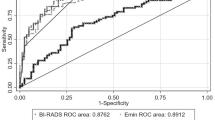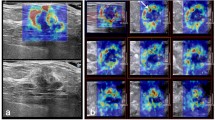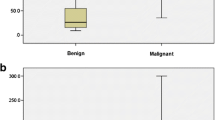Abstract
Objectives
To evaluate the diagnostic performance of shear-wave elastography (SWE) for breast cancer and to determine whether the integration of SWE into BI-RADS with subcategories of category 4 improves the diagnostic performance.
Methods
A total of 389 breast masses (malignant 120, benign 269) in 324 women who underwent SWE before ultrasound-guided core biopsy or surgery were included. The qualitative SWE feature was assessed using a four-colour overlay pattern. Quantitative elasticity values including the lesion-to-fat elasticity ratio (Eratio) were measured. Diagnostic performance of B-mode ultrasound, SWE, or their combined studies was compared using the area under the ROC curve (AUC).
Results
AUC of Eratio (0.952) was the highest among elasticity values (mean, maximum, and minimum elasticity, 0.949, 0.939, and 0.928; P = 0.04) and AUC of colour pattern was 0.947. AUC of combined studies was significantly higher than for a single study (P < 0.0001). When adding SWE to category 4 lesions, lesions were dichotomised according to % of malignancy: 2.1 % vs. 43.2 % (category 4a) and 0 % vs. 100 % (category 4b) for Eratio and 2.4 % vs. 25.8 % (category 4a) for colour pattern (P < 0.05).
Conclusions
Shear-wave elastography showed a good diagnostic performance. Adding SWE features to BI-RADS improved the diagnostic performance and may be helpful to stratify category 4 lesions.
Key points
• Quantitative and qualitative shear-wave elastography provides further diagnostic information during breast ultrasound.
• The elasticity ratio (E ratio ) showed the best diagnostic performance in SWE.
• E ratio and four-colour overlay pattern significantly differed between benign and malignant lesions.
• SWE features allowed further stratification of BI-RADS category 4 lesions.





Similar content being viewed by others
References
Bercoff J, Tanter M, Fink M (2004) Supersonic shear imaging: a new technique for soft tissue elasticity mapping. IEEE Trans Ultrason Ferroelectr Freq Control 51:396–409
Athanasiou A, Tardivon A, Tanter M, Sigal-Zafrani B, Bercoff J, Deffieux T, Gennisson JL, Fink M, Neuenschwander S (2010) Breast lesions: quantitative elastography with supersonic shear imaging–preliminary results. Radiology 256:297–303
Evans A, Whelehan P, Thomson K, McLean D, Brauer K, Purdie C, Jordan L, Baker L, Thompson A (2010) Quantitative shear wave ultrasound elastography: initial experience in solid breast masses. Breast Cancer Res 12:R104
Tozaki M, Fukuma E (2011) Pattern classification of ShearWave Elastography images for differential diagnosis between benign and malignant solid breast masses. Acta Radiol 52:1069–1075
Chang JM, Moon WK, Cho N, Yi A, Koo HR, Han W, Noh DY, Moon HG, Kim SJ (2011) Clinical application of shear wave elastography (SWE) in the diagnosis of benign and malignant breast diseases. Breast Cancer Res Treat 129:89–97
Berg WA, Cosgrove DO, Dore CJ, Schafer FK, Svensson WE, Hooley RJ, Ohlinger R, Mendelson EB, Balu-Maestro C, Locatelli M, Tourasse C, Cavanaugh BC, Juhan V, Stavros AT, Tardivon A, Gay J, Henry JP, Cohen-Bacrie C, Investigators BE (2012) Shear-wave elastography improves the specificity of breast US: the BE1 multinational study of 939 masses. Radiology 262:435–449
Evans A, Whelehan P, Thomson K, Brauer K, Jordan L, Purdie C, McLean D, Baker L, Vinnicombe S, Thompson A (2012) Differentiating benign from malignant solid breast masses: value of shear wave elastography according to lesion stiffness combined with greyscale ultrasound according to BI-RADS classification. Br J Cancer 107:224–229
American College of Radiology (2003) Breast imaging reporting and data system (BI-RADS), 4th edn. American College of Radiology, Reston
Hong AS, Rosen EL, Soo MS, Baker JA (2005) BI-RADS for sonography: positive and negative predictive values of sonographic features. AJR Am J Roentgenol 184:1260–1265
Lazarus E, Mainiero MB, Schepps B, Koelliker SL, Livingston LS (2006) BI-RADS lexicon for US and mammography: interobserver variability and positive predictive value. Radiology 239:385–391
Kim EK, Ko KH, Oh KK, Kwak JY, You JK, Kim MJ, Park BW (2008) Clinical application of the BI-RADS final assessment to breast sonography in conjunction with mammography. AJR Am J Roentgenol 190:1209–1215
Raza S, Chikarmane SA, Neilsen SS, Zorn LM, Birdwell RL (2008) BI-RADS 3, 4, and 5 lesions: value of US in management—follow-up and outcome. Radiology 248:773–781
Chang JM, Moon WK, Cho N, Kim SJ (2011) Breast mass evaluation: factors influencing the quality of US elastography. Radiology 259:59–64
DeLong ER, DeLong DM, Clarke-Pearson DL (1988) Comparing the areas under two or more correlated receiver operating characteristic curves: a nonparametric approach. Biometrics 44:837–845
Marcy PY, Thariat J, Lacout A (2012) Should we catch the train of shear-wave elastography? AJR Am J Roentgenol 198:W624–W625
Barr RG, Zhang Z (2012) Effects of precompression on elasticity imaging of the breast: development of a clinically useful semiquantitative method of precompression assessment. J Ultrasound Med 31:895–902
Barr RG (2012) Sonographic breast elastography: a primer. J Ultrasound Med 31:773–783
Youk JH, Jung I, Kim EK, Kim MJ, Son EJ, Moon HJ, Kwak JY (2012) US follow-up protocol in concordant benign result after US-guided 14-gauge core needle breast biopsy. Breast Cancer Res Treat 132:1089–1097
Cosgrove DO, Berg WA, Dore CJ, Skyba DM, Henry JP, Gay J, Cohen-Bacrie C (2012) Shear wave elastography for breast masses is highly reproducible. Eur Radiol 22:1023–1032
Acknowledgements
This research was supported by the Basic Science Research Programme through the National Research Foundation of Korea (NRF) funded by the Ministry of Education, Science and Technology (2011–0007602).
Author information
Authors and Affiliations
Corresponding author
Rights and permissions
About this article
Cite this article
Youk, J.H., Gweon, H.M., Son, E.J. et al. Diagnostic value of commercially available shear-wave elastography for breast cancers: integration into BI-RADS classification with subcategories of category 4. Eur Radiol 23, 2695–2704 (2013). https://doi.org/10.1007/s00330-013-2873-3
Received:
Revised:
Accepted:
Published:
Issue Date:
DOI: https://doi.org/10.1007/s00330-013-2873-3




